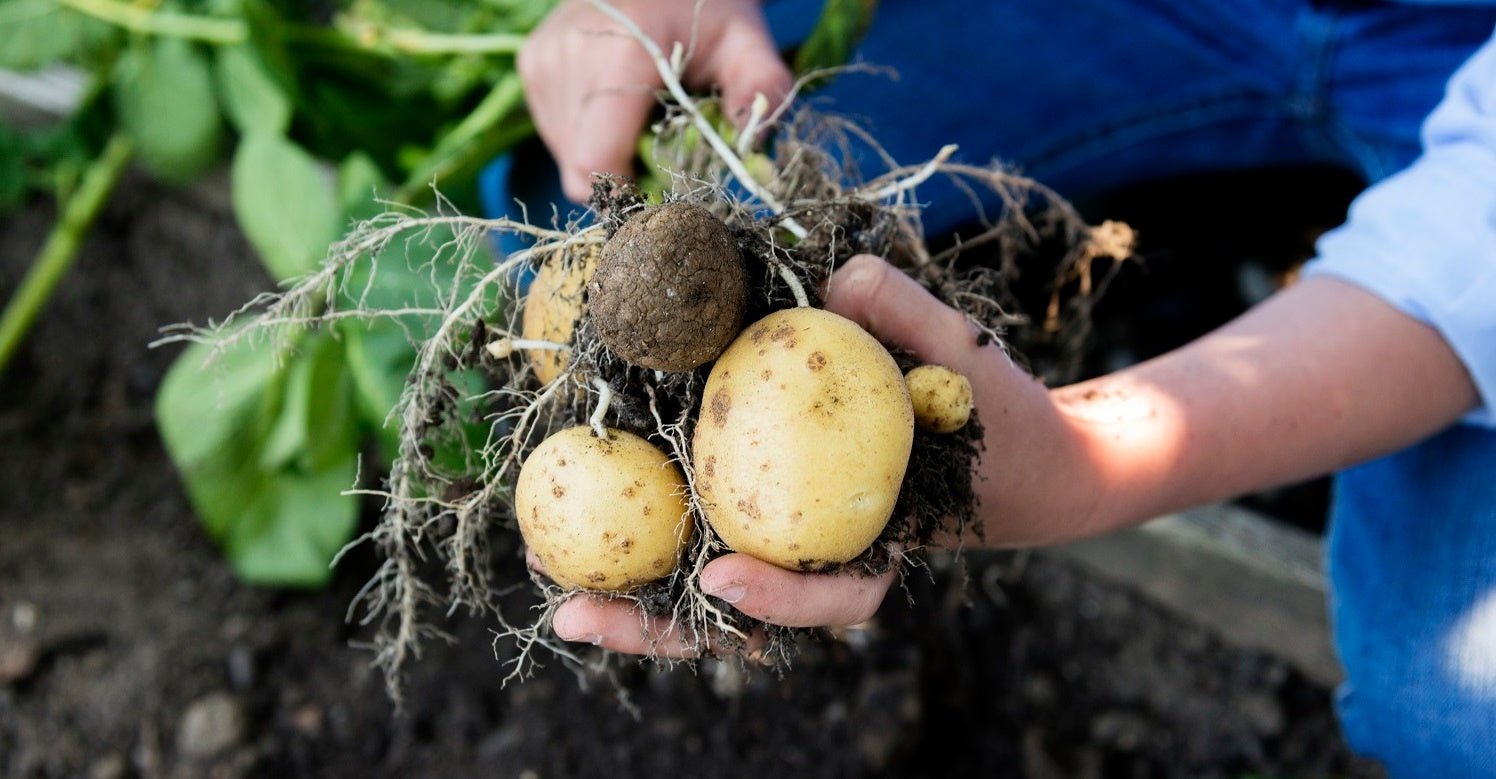
How to Grow Potatoes and Sweet Potatoes in Your Organic Garden
Most holiday dinner tables will have some variation of potatoes and/or sweet potatoes. Plan now to grow your own in your organic garden for next year’s dinner!
n
Most holiday dinner tables will have some variation of potatoes and/or sweet potatoes. Plan now to grow your own in your organic garden for next year’s dinner! 



How to Grow Potatoes
A favorite root crop, the humble potato is easy to grow. It will store for many months, and there are countless ways to prepare it over the winter.- Start with seed potatoes from a local farm, reputable nursery, or seed company, some of which deal exclusively in potatoes. Once you grow your own, though, you can save your own seed potatoes. These are not seeds! They are small potatoes that you cut up and plant. They will be delivered to you at planting time. Keep them cool in your refrigerator. Take them out a week before you plant in mid-spring.
- Meanwhile, prepare your soil. Potatoes are adaptable and will tolerate less than optimal soil. Ideally, though, it should be loose and well-draining with a slightly acidic pH of 5.8-6.5. Potatoes are heavy feeders, so till in lots of good quality compost.
- Potatoes need full sun and cool weather. Plant when the soil temperature is above 45ºF. Cut the seed potatoes so there are two eyes on each piece. Plant them 12-15” apart in rows 2.5’ apart, and 6-8” deep with the eyes pointing up. Cover with 4” of soil. They will sprout in a couple of weeks. When the sprouts are 8-12” tall, cover them halfway with soil. This is called ‘hilling’. Every couple weeks, hill soil around the plants again about halfway up. Continue doing this until the plants flower. Tubers will form in the soil you are hilling up.

- Potatoes need an inch of water a week, and more during dry spells. You can dig new potatoes when the plants start to flower. When the foliage begins to die back, stop watering. Two to three weeks later, harvest your full-size potatoes. Dig carefully with a dung fork. Damaged tubers are edible, but won’t keep. Cure them in a dry place for a few days to toughen the skins. They store best in cool, dark, humid conditions.
- Potatoes can be plagued by Colorado potato beetles, aphids, cutworms, wireworms, and flea beetles. Rotate your potato bed for three years to reduce infestations and diseases such as black leg, blight, verticillium wilt, and ring rot. Buy certified, resistant varieties, keep the garden clean, and water from below for a healthy potato garden.
- These are the favorite potato varieties from the Potato Association of America, and here is a recipe for Roasted Rosemary and Garlic Potatoes.
How to Grow Sweet Potatoes
Their names are similar, but that’s the end of the likenesses between potatoes and sweet potatoes. They are different species with very different growing conditions. Sweet potatoes need a long hot season. If you have a short season, though, there are now cultivars suitable to your climate.
- Buy root pieces from a reputable nursery or online garden supply store. Check with a local farm, or with friends who grew them. Do not use store bought sweet potatoes. They are treated to prevent sprouting.
- About eight weeks before planting, place the pieces in moist sand, and keep in a warm spot, about 75ºF. You could also put a tuber in a jar of water to sprout. When the sprouts, also called slips, are at least 6” long, remove them, and plant them outside. There should be roots on the bottom. If not, place them in soil or water until they root. You can also buy slips from a garden supplier. Be sure they are suitable for your garden zone.
- Transplant the rooted slips into the garden 2-4 weeks after your last frost, when the soil temperature is at least 60ºF. If you need to warm the soil, cover it with black plastic for a few weeks. Sweet potatoes need acidic soil, with a pH of 5-6.5. They like phosphorus and potassium, and not much nitrogen. Do a soil test, and add the recommended amendments. Incorporate compost for light, well-draining soil.
- Make raised rows about 6” high and 3.5’ apart. Plant your slips 12” apart, and bury them up to the first leaves. Add compost to each hole. Water in well after planting, but wait a couple weeks before mulching. This will help the soil warm further. About 4 weeks after planting, fertilize with organic 5-10-10. The vines will root where they touch the ground, so lift them gently once in a while to prevent this. Give your sweet potatoes 1” of water a week.
- Harvest when the foliage begins to yellow but before the first frost. Dig about 18” away from the center of the plant. Sweet potatoes bruise easily, so be careful handling them. Cure in a warm (85ºF), dry area for two weeks. Store them at 55ºF with high humidity. They taste best after being stored for a couple of months.
- Pests and diseases to watch for are flea beetles, wireworms, nematodes, fungal leaf rot, and stem rot. Practice a four-year rotation, buy resistant varieties, do not overwater, and keep the garden cleaned up.
- These are common sweet potato varieties. Try this recipe my sister sent me for Sweet Potato Casserole with Butter Pecan Crumble Topping, or this one for Twice Baked Sweet Potatoes with Crunchy Topping.
- Potatoes and sweet potatoes are suitable for container gardening. Large pots, heavy duty lawn and leaf bags, grow bags, or even a stack of tires will suffice.
Plan now to grow food for your holiday table. Have a safe, healthy, and happy season!
Would you like to be the first to hear about our new products and more? Sign up for our Nature’s Path Newsletter.

